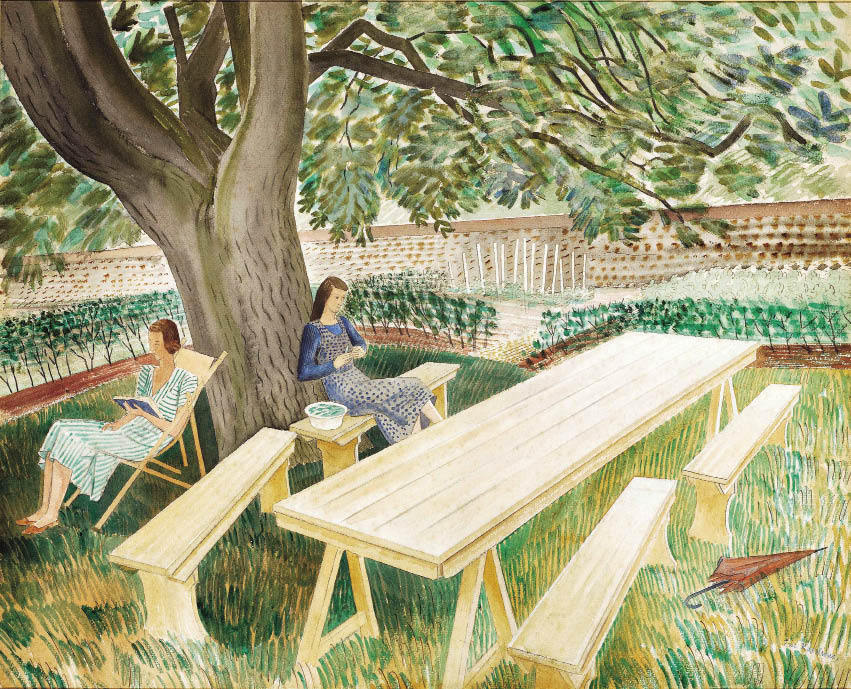The Fry Art Gallery is housed in a Victorian Gentleman’s Gallery of two main rooms, built in 1856 for the Quaker banker Francis Gibson.
The Fry Art Gallery is housed in a Victorian Gentleman’s Gallery of two main rooms, built in 1856 for the Quaker banker Francis Gibson. It was first intended to accommodate his own collection, but was always open to the public, and in 1985 it was taken over by the Fry Art Gallery Society, a charity set up to create the North West Essex Collection, of work by artists of the locality.
The focus is primarily on the remarkable group of painters and printmakers who settled in nearby Great Bardfield from the 1930s to the 1970s, and which included Edward Bawden and Eric Ravilious, John Aldridge, Michael Rothenstein and Kenneth Rowntree. The Fry’s permanent collection is now a considerable resource, and in addition the gallery mounts regular temporary displays to broaden its appeal. The current show is devoted to the last decade in the tragically short life of Eric Ravilious (1903–42), dealing with the years when he actually lived in Essex.
Ravilious was a brilliant draughtsman who used watercolour to tint and animate his compositions. (Interestingly, his works were referred to as watercolour drawings.) But his mastery of watercolour should not be played down: at art school he discovered the previously rather overlooked 18th-century topographical watercolourist Francis Towne, and later he studied the very different but inspiring techniques of Cotman and Samuel Palmer. At the Royal College, Rav (as he was affectionately known) was directly influenced by the teaching of Paul Nash, himself a master of watercolour and the ways it might be used in a modern context. In fact, although Ravilious was no radical modernist, he managed to achieve a sort of sublime timelessness in his cool and classical use of the medium; a style the lucidity of which is instantly recognisable.
In 1932, Ravilious and his wife Tirzah moved to Great Bardfield to share Brick House with their friends Edward and Charlotte Bawden. Ravilious and Bawden worked well together, and had recently collaborated on some well-received murals for Morley College in London. A mutual friend, the wood-engraver Douglas Percy Bliss, described their relationship: ‘Eric admired Edward’s dour creativeness, his sheer professionalism, and Edward believed in the elegance and fastidious taste with which Eric was endowed. They worked together in perfect amity.’ Nevertheless, there was inevitably some degree of friction between the two couples, and in September 1934 Eric and Tirzah moved to their own home at Bank House in Castle Hedingham, before their final move in 1941 to Ironbridge Farm, near Shalford. Meanwhile, the contemporary taste for country life, mirrored by a kind of 1930s diaspora of writers and artists leaving the cities to live in villages, helped to create a market for Ravilious’s distinctive watercolours, which began to sell well.
In the smaller of the two galleries at the Fry is a superb display of 18 Ravilious watercolours, prefaced by a piquant ink portrait of him by his friend and colleague Thomas Hennell, another artist to die in the second world war. One of the key paintings here is ‘Prospect from an Attic’, a vista of backyards, roofs and trees, painted from the roof of Brick House when it was being repaired. It has a little of the magic realism of John Nash’s early work, but a crisp linearity that is all Ravilious’s own. Another memorable subject is ‘Village Street’, actually Falcon Square in Castle Hedingham, across which a man and a woman cycle on a wet day. ‘Late August Beach’ depicts a group of 19th-century bathing machines at Aldeburgh, wheeled huts drawn up among the boats and a prominent anchor. There are a number of unfamiliar images borrowed from private collections (such as the hallucinatory ‘Tree Trunk and Wheelbarrow’ or the pale but beautifully structured ‘Ironbridge at Ewenbridge’) and cabinets of books illustrated by Ravilious, from the celebrated High Street, to Twelfth Night and the Cornhill Magazine.
The main gallery is full of treasures, including the recent Fry acquisition ‘Caravans’ by Ravilious, from 1936, and a wall of his 1941 submarine lithographs. There are also good things by Kenneth Rowntree, Keith Vaughan and Michael Ayrton, as well as lesser-known but demonstrably interesting artists such as Sheila Robinson. Display drawers house a number of fascinating preparatory drawings as well as some of Edwin Smith’s evocative photographs. The other major presence here is Bawden, with a room off the entrance hall given over to him (though it includes a wall cabinet of Wedgwood china decorated by Ravilious), and several of his splendid large linocuts and wallpaper designs on prominent view. The gallery is open, admission free, Tuesday, Friday and Sunday afternoons, and all day Saturday (11am to 5pm), and offers a wide range of publications and some original art for sale.
The exhibition also launches a new book on Ravilious, the third in a series of monographs on the artist published by the Mainstone Press, with the general title of Ravilious in Pictures. The previous books focused on Sussex and the Downs (2009) and The War Paintings (2010), the new one being A Country Life, and dealing with Ravilious in Essex and Suffolk. These slim, elegantly designed, landscape-format hardbacks are extremely good value at £25. Each contains an introduction by James Russell, and then detailed commentary on the 20 full-page colour plates. Russell writes clearly and entertainingly, displaying an extensive knowledge of Ravilious’s life and the wider social and historical context in which he worked.
Russell suggests that what attracted Ravilious to Essex was ‘perhaps less the landscape than the continuing survival in that isolated region of human enterprise on an intimate scale…the villages of rural Essex remained essentially local, pedestrian and old-fashioned’. Thus Ravilious was able to find enough subjects for his watercolours that interested him. Brought up over an antique shop, like another gifted 20th-century English watercolourist, John Ward, Ravilious developed an eye for relics of the past, for the forgotten and generally unregarded, and for antiquated machinery in particular. (Among the book’s illustrations are poignant depictions of an abandoned Talbot-Darracq motorcar, a steam-powered tractor and the wooden skeleton of a No. 29 bus.) Ravilious’s careful scrutiny of his subject is matched by the close attention that Russell pays the artist’s pictures, and the enthusiasm with which he explains them. Both book and exhibition are highly recommended.






Comments